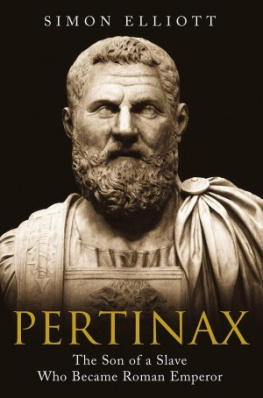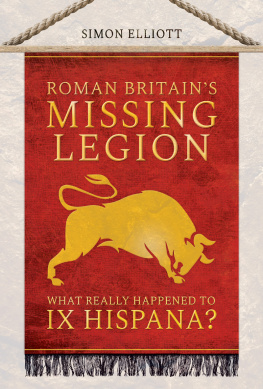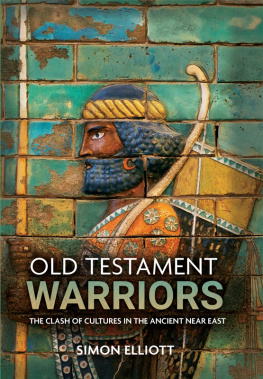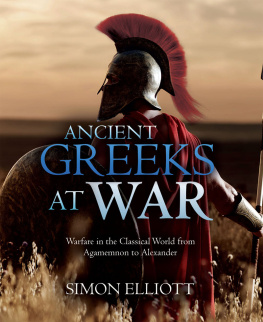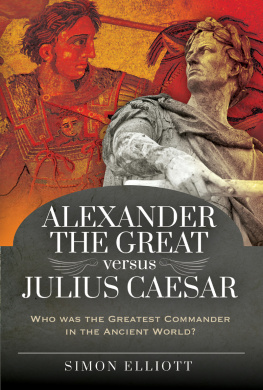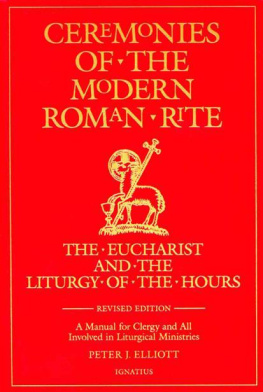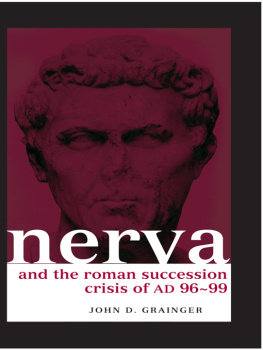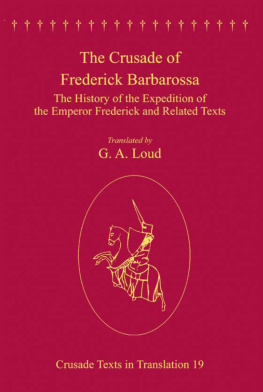Simon Elliott - Pertinax: The Son of a Slave Who Became Roman Emperor
Here you can read online Simon Elliott - Pertinax: The Son of a Slave Who Became Roman Emperor full text of the book (entire story) in english for free. Download pdf and epub, get meaning, cover and reviews about this ebook. year: 2020, publisher: Greenhill Books, genre: Religion. Description of the work, (preface) as well as reviews are available. Best literature library LitArk.com created for fans of good reading and offers a wide selection of genres:
Romance novel
Science fiction
Adventure
Detective
Science
History
Home and family
Prose
Art
Politics
Computer
Non-fiction
Religion
Business
Children
Humor
Choose a favorite category and find really read worthwhile books. Enjoy immersion in the world of imagination, feel the emotions of the characters or learn something new for yourself, make an fascinating discovery.
- Book:Pertinax: The Son of a Slave Who Became Roman Emperor
- Author:
- Publisher:Greenhill Books
- Genre:
- Year:2020
- Rating:4 / 5
- Favourites:Add to favourites
- Your mark:
- 80
- 1
- 2
- 3
- 4
- 5
Pertinax: The Son of a Slave Who Became Roman Emperor: summary, description and annotation
We offer to read an annotation, description, summary or preface (depends on what the author of the book "Pertinax: The Son of a Slave Who Became Roman Emperor" wrote himself). If you haven't found the necessary information about the book — write in the comments, we will try to find it.
Pertinax: The Son of a Slave Who Became Roman Emperor — read online for free the complete book (whole text) full work
Below is the text of the book, divided by pages. System saving the place of the last page read, allows you to conveniently read the book "Pertinax: The Son of a Slave Who Became Roman Emperor" online for free, without having to search again every time where you left off. Put a bookmark, and you can go to the page where you finished reading at any time.
Font size:
Interval:
Bookmark:
PERTINAX
by the same author
Sea Eagles of Empire
Empire State:
How the Roman Military Built an Empire
Septimius Severus in Scotland
Roman Legionaries
Ragstone to Riches
Julius Caesar: Romes Greatest Warlord
Old Testament Warriors

PERTINAX
The Son of a Slave
Who Became Roman Emperor
SIMON ELLIOTT
Greenhill Books

Pertinax
First published in 2020 by
Greenhill Books,
c/o Pen & Sword Books Ltd,
47 Church Street, Barnsley,
S. Yorkshire, S70 2AS
www.greenhillbooks.com
contact@greenhillbooks.com
ISBN: 9781784385255
All rights reserved.
Simon Elliott, 2020
The right of Simon Elliott to be identified as author of this work has been asserted in accordance with Section 77 of the Copyrights Designs and Patents Act 1988.
CIP data records for this title are available from the British Library Designed and typeset by Donald Sommerville
Printed and bound in the UK by TJ International Ltd, Padstow Typeset in 10.7/15 pt Kuenstler 480 BT
In memory of our friend Dino Monticoli,
a fearsome warrior both on and off
the wargaming tabletop.
Remembered with love by your family and friends.
Contents
List of Plates ix
Chapter 1The Early Life of Pertinax 15
Chapter 2Background: The Principate Empire 32
Chapter 3Background: The Principate Military 58
Chapter 4A Life in the Legions 80
Chapter 5Squadron Commander to Provincial Governor 101
Chapter 6Emperor of Rome 131
Conclusion
TimelineThe Roman Empire of the Second Century ad 194
References and Bibliography
Index 210
Map
Provinces of the Roman Empire in the late 2nd century ad 3839
Tables
1: Roman legions in the later 2nd century 6667
2: Auxiliary Cohorts and Alae of the later 2nd century 7172
3: Regional Fleets of the Roman Principate 73
Plates
The bust of Pertinax in the Vatican Museum.
The Column of Marcus Aurelius in Rome.
Marcus Aurelius and Lucius Verus address their troops, detail on the Column of Marcus Aurelius.
Roman cavalry, legionaries, marines and auxilia during the Marcomannic Wars, Column of Marcus Aurelius.
Cavalry and auxilia in action, Column of Marcus Aurelius.
Bust of Marcus Aurelius.
Roman legionaries building a marching camp, Trajans Column.
The miracle of rain incident, as recorded on the Column of Marcus Aurelius.
Roman legionaries in testudo formation, Column of Marcus Aurelius.
The young Commodus.
Mad, bad Commodus, whose assassination led to Pertinax becoming emperor.
Stadium of Domitian in the imperial palace on the Palatine Hill in Rome.
The Rome of Pertinax: the Flavian Colosseum, Forum Romanum and Palatine Hill.
Principate Roman legionaries, detail from Trajans Column, Rome.
Sarmatian armour and standards, Trajans Column.
Sarmatian and Dacian trophies for Trajan, base of Trajans Column.
Ruins of Ostia, the port of Rome.
Roman merchant ship in a mosaic in Ostia Antica.
Roman river war galley, from the legionary fortress at Mainz.
[ ix ]
Pertinax
The Brhl inscription, a vital piece of evidence detailing much of Pertinaxs imperial service.
Riverine galleys on the Danube, Trajans Column.
Bridge of boats built across the Danube by Trajan.
Wall of the Roman legionary fortress at York.
Multangular Tower, York.
Dere Street, next to the Roman fort at Newstead near Melrose in the Scottish Borders.
The Trimontium Stone, marking the site of the Roman fort at Newstead.
The Roman villa at Lullingstone in Kent.
Detail of the Roman villa at Lullingstone.
Roman amphitheatre, London.
The defaced bust, thought to be of Pertinax, found at Lullingstone.
The Arch of Septimius Severus in the Forum Romanum.
All photographs Simon Elliott. All rights reserved.
[ x ]
Introduction
Publius Helvius Pertinax was the emperor who proved that no matter how lowly your birth, within the Roman Empire you could rise to the very top through hard work, grit and determination. In his case he also did it by endeavouring to be a good role model, styling himself on his sometime benefactor Marcus Aurelius. He was also highly thought of by contemporaries, the Greek historian Cassius Dio (74.1) calling him an excellent and upright man and Herodian (2.1.4) saying he was famous for his accomplishments, both civil and military; he had won many victories over the Germans and the Eastern barbarians. Modern commentators are equally flattering; with Birley (1999, 63) saying he was one of the most remarkable figures of... any age of Roman history. In short, given that he was the son of a manumitted slave and only joined the cursus honorum, the aristocratic career path, later in life, his story is unique among the lengthy list of Roman emperors.
Because of the trajectory of Pertinaxs career through Roman society from low to high, this everyman also presents us with a unique prism through which to view the multifarious nature of the Principate Roman Empire at its height in the later second century ad. To that end, this is not just a biography of the man himself, but also the story of the dramatic times in which he lived.
Pertinax was born on 1 August in ad 126. He was initially a grammarian or teacher. He then chose a career in the army in his mid-thirties, a very late age for such a switch, with the support of a senior family patron. This launched him on a highly unusual and successful journey along the cursus honorum. Initially made an
[ 1 ]
Pertinax
equestrian (he was later adlected into the Senate, meaning he was able to skip the early qualifications necessary for this), he made his name fighting as a cavalry officer in the RomanParthian War in the east from 161 to 166.
He then had his first taste of life in the troublesome province of Britannia, serving as a military tribune (senior officer) in legio VI Victrix based in York and then as the commander of an auxiliary unit, either I or II Tungrorum. In both roles he served along Hadrians Wall, then recently restored as the northern frontier in Britain after the abandonment of the Antonine Wall, and campaigned north into Scotland. This set a pattern for him being an imperial troubleshooter, always serving in provinces where serious action was guaranteed.
He was next appointed to take charge of a squadron in Moesia Superior or Inferior, either of cavalry or as a navarchus in the ClassisFlavia Moesica, the regional fleet on the lower Danube. He then served in a procuratorial civilian post in Italy before returning west as the Praefectus Classis or admiral of the Classis Germanica on the River Rhine. Heading back east again, he was next the procurator of the province of Dacia, the militarised redoubt standing proud of the Danube, during the early stages of the Marcomannic Wars of Marcus Aurelius and Lucius Verus. It was then through the influence of another patron that he was able to secure more imperial favour here, though at some stage he fell foul of court intrigue and was recalled to Rome. Pertinax was soon back in action on the Danube again, given his value as a military leader, before a major promotion as suffect consul in Rome. This was an appointment to the most senior magisterial position in the imperial capital, the term suffect meaning that he was appointed to complete the consular year of an office holder who had stepped down. Having filled this role he was then eligible to become a provincial governor, serving as such in the key frontier provinces of Moesia Inferior and Superior on the Danube, in Dacia again, in Syria where he fought the Parthian Empire once more, in Britain, and finally in Africa Proconsularis as proconsul. In Britain he overstepped the
Next pageFont size:
Interval:
Bookmark:
Similar books «Pertinax: The Son of a Slave Who Became Roman Emperor»
Look at similar books to Pertinax: The Son of a Slave Who Became Roman Emperor. We have selected literature similar in name and meaning in the hope of providing readers with more options to find new, interesting, not yet read works.
Discussion, reviews of the book Pertinax: The Son of a Slave Who Became Roman Emperor and just readers' own opinions. Leave your comments, write what you think about the work, its meaning or the main characters. Specify what exactly you liked and what you didn't like, and why you think so.

